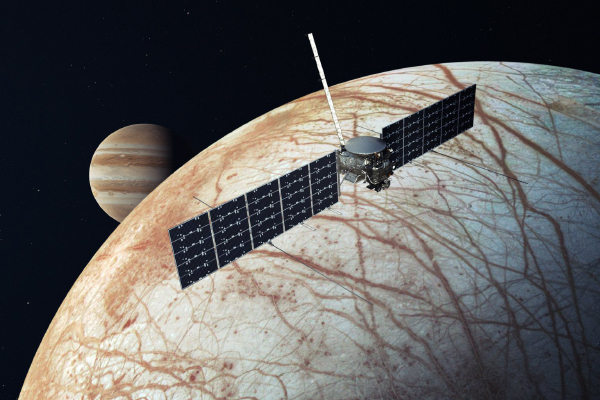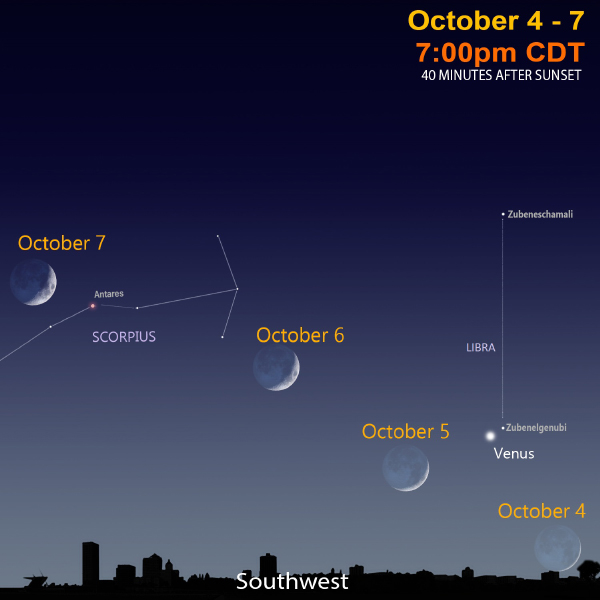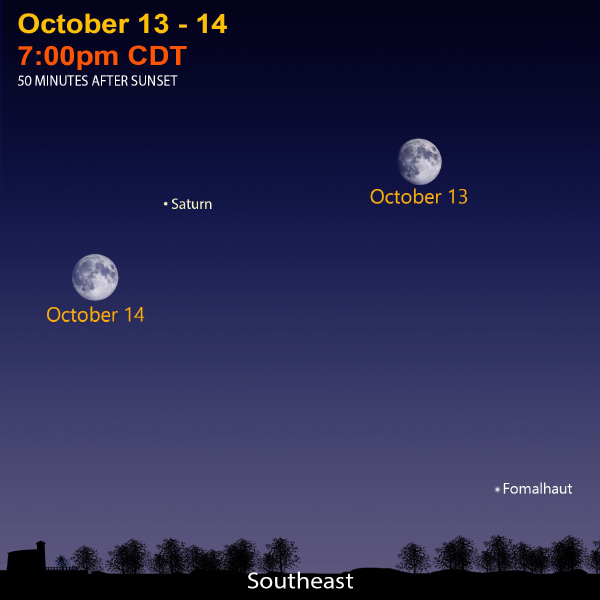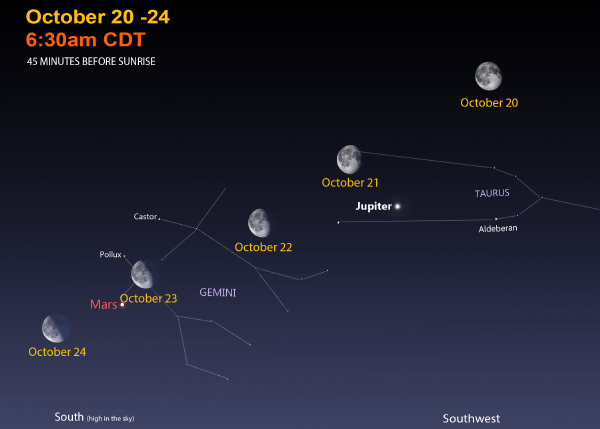Cosmic Curiosities
“In awe, I watched the waxing moon ride across the zenith of the heavens like an ambered chariot towards the ebony void of infinite space, wherein the tethered belts of Jupiter and Mars hang, forever festooned in their orbital majesty. And as I looked at all this, I thought, I must put a roof on this toilet.”
- Les Dawson, English Comedian, Writer, & Actor
A Very Distant Ocean

Very soon, a launch window opens for the Europa Clipper. This new spacecraft is set to blast off on October 10, 2024, for a 5.5-year journey to Jupiter. Its primary target is Europa, one of the four major moons discovered by Galileo more than 400 years ago.
Why Europa?
Back in 1979, NASA’s Voyager 2 probe eyed Europa and found a strange discovery: Its surface was smooth with fracture features and only a few craters. These clues led science detectives to theorize Europa was active! Something below was resurfacing and causing changes to Europa’s icy crust. The main suspect? A vast underground liquid ocean!
The possibility that this submerged liquid could be water got people at NASA excited. Because where there is water, there could be life. Every living species on our planet is more than 50% water by weight. We humans are more than 60% water. Some scientists say the ocean below Europa is salt water, and the amount surpasses all the water in Earth’s oceans.
Europa being stretched and heated by Jupiter’s gravity; Credit: NASA
Water Cause
So why does Europa have water beneath the ice when it’s about 500 million miles from the sun—more than five times the distance of Earth? It’s Jupiter’s great gravity.
Europa flexes due to its proximity to the largest planet. This is a result of tidal forces. Jupiter pulls on the closer side of Europa more than its far side. All this uneven tugging creates heat and friction and helps make liquid water underneath Europa’s icy surface. All this tidal energy may create chemical reactions with rocks at the ocean floor, which possibly might make the necessary ingredients for life.
MISSION GOALS
Europa Clipper’s main goal is spotting conditions that could make life possible, by close examination of the icy surface and ocean below. Currently, the icy layer is estimated to be 12 miles thick.
The spacecraft is as big as a basketball court with its solar arrays extended. It arrives in April 2030 with a mission time of four years. The spaceship is to orbit past Europa 49 times, dipping close to dangerous radiation levels emitted by Jupiter. It should get as close as 16 miles to the moon’s surface.
This mission will also help us with the next mission. Someday in the future, we humans may send a probe to Europa that can penetrate the ice and explore this distant ocean up close!
Solar Sail to the Stars
The night sky has a new sparkling object streaking across! NASA launched their Advanced Composite Solar Sail System (ACS3) on April 23, and on August 29, it successfully deployed its sails in low Earth orbit.
Solar Sail; Credit NASA
This small spacecraft isn’t venturing out to the stars just yet. The idea now is to test material technologies for optimal propulsion strategies. Some say a solar sail could be built within a generation that could reach Alpha Centauri, the nearest star system to Earth, in 20 years. The tiny spacecraft would need to travel at 20% of the speed of light.
A solar sail is like a sailboat, but it uses the pressure of the sun’s photons instead of wind. This free energy provides constant propulsion and diminishes any need for expensive and heavy rocket fuel. The sail’s surface is reflective of the mirror, and the light reflecting provides the forward force.
The sail is large, each side about 30 feet long, and comprised of four triangular-shaped sections made of polymer and carbon fiber. It is collapsible, lightweight, and can be stored indefinitely, as opposed to fuel propellants which can expire, as they are only limited by the durability of the sails’ materials. Weight and cost are incredibly important in planning out a mission to a distant star. A solar sail is expected to reach high speeds without carrying heavy fuel.
The first successful interplanetary system was launched by Japan Aerospace Exploration Agency (JAXA) in 2017 with IKAROS (Interplanetary Kite-craft Accelerated by Radiation of the Sun), named for the Greek myth of Icarus, the boy who flew close to the sun on wings made of paper and wax.
Stargazers often notice satellites in the night sky. They look like slow-moving stars, but they are moving five miles per second as they orbit the Earth. The International Space Station (ISS) is a fun one to spot, because you can wave at the astronauts! Viewers can also find ACS3. Use NASA’s mobile app, which provides location-specific schedules of when the sail is visible in the night sky. This is similar to NASA’s “Spot the Station” for the ISS and SpaceX’s “Find Starlink” for the respective satellite system, which are both web applications to find the approximate time and direction for viewing in the night sky.
Unfortunately, as more satellites and systems are launched into space, the darkness of our nighttime sky decreases, making stargazing increasingly difficult in our modern world. Individuals have to drive out farther to see the stars, which may not be accessible or possible for many. As these satellites and objects are often visible in city skies, while they bring a curiosity about the stars, they also represent an increase in “UFO” sightings.
Download NASA’s app today and see if ASC3 is visible in your area tonight; just don’t confuse it with a shooting star!
The Artistic Universe
The Daniel M. Soref Planetarium is creating a new program called The Artistic Universe. We hope to engage and educate our audiences on the beauty of both art and science—and to reveal how art and science are more alike than different.
One scene centers around perhaps the most famous painting of the night sky: Vincent Van Gogh’s Starry Night. Van Gogh based his painting on what he saw in the pre-dawn sky in June 1889.
Enjoy the sneak preview below. This program will open in the spring of 2025.
Space in Sixty Seconds
See Jupiter in the sky and preview a new Earth-visitor to one of its moons, Europa!
Sky Sights
Watch a sliver Moon pass Venus on October 4 and 5. See if you can spot the “Zubee” stars of Libra, too. Then on October 6 and 7, see our brightest nightlight pass the red star Antares in Scorpius.
On the nights of October 13 and 14, observe the Moon pass Saturn.
The Moon glides by Jupiter from October 20 through 22 high in the morning sky amongst the bright stars of Taurus the Bull. Then, watch the moon pass red Mars the next two nights, October 23 and 24.
Mercury is too difficult to see this month.
On an enchanting Halloween night, one hour after sunset, spot planets Venus and Saturn, and the bright stars of the Summer Triangle, the Big Dipper, and Cassiopeia. And who knows what else you might see...?
October Star Map
Sign Up
Receive this newsletter via email!
Subscribe
See the Universe through a telescope
Join one of the Milwaukee-area astronomy clubs and spot craters on the Moon, the rings of Saturn, the moons of Jupiter, and much more.
Follow Bob on social media
Twitter: @MPMPlanetarium
Facebook: Daniel M. Soref Planetarium




